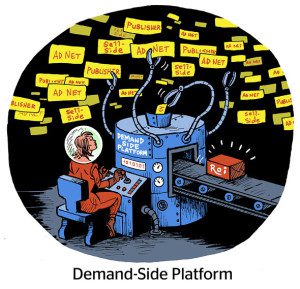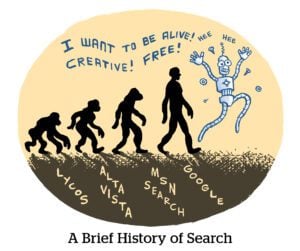Howdy, readers! This is James Hercher, back from break with the latest and greatest in commerce news.
This week, we’re looking at a topic that is new, but it’s grown so quickly it already feels old hat. And that’s machine learning tech consuming open web ad budgets as big walled gardens consolidate media, data, tech and audiences inside their own fortresses.
The PMax phenom
Two weeks ago, at the We Make Future conference in Remini, Italy, Pierpaolo Morgante, a Microsoft Advertising senior client solutions manager, touted in a presentation that the group is “building our own version of Performance Max” to launch this summer. (H/t Mike Ryan of the consultancy Smarter Ecommerce for clocking it.)
Google probably isn’t pleased that its product’s name, “Performance Max,” has become a general shorthand for black-box ad products that walled gardens use to centralize media and data, while reporting little to no data back to advertisers.
But almost every large platform has its version of “Performance Max.”
TikTok’s is called Smart Performance Campaigns, while Meta has Advantage+ Shopping Campaigns (ASC). Microsoft Advertising is in testing and hasn’t floated a product name aside from “our own version of Performance Max.”
Why are they all doing it? Because the “Performance Max” approach takes the walled garden model a step further by giving the platform control over targeting, measurement and creative and by combining multiple media channels into one black box. Rather than constantly tuned campaigns based on specific audience or behavioral niches, the advertiser’s campaign controls become the rates they set for cost-per-conversion metrics, the creative they upload to the system and sometimes broad audience or geographic targets.
“Just switch it on at a click of a button in your ad group settings and Microsoft will use your existing assets to find the right audiences for your campaigns,” according to a Microsoft Advertising blog post last week introducing Predictive Targeting, the group’s first ad tech product with native AI integrations.
The biggie platforms are clearly all-in on machine learning-based advertising. The question is whether machine learning technology is ready for primetime?
Machine Unlearning
Google’s PMax is the pioneer of ad platform AI products, but Meta ASC is the one to watch.
ASC is a bellwether for whether other platforms – everyone is already claiming to have their own “PMax” – will be able to pull off the same trick.
That’s because Meta is full steam ahead with ASC and machine learning is taking over its ad platform despite setbacks and even flagrant red flags.
Last month, one of Meta’s new machine learning optimization products bugged out, costing advertisers tens if not hundreds of millions of dollars, most of which Meta refunded in ad credits.
This incident might foreshadow what advertising will be in a machine learning platform era.
Marketers that spend tens of millions of dollars per year on Meta couldn’t get a hold of a human account rep for days, while the automated system failed utterly to resolve the issue or customer complaints.
Meanwhile, Meta’s ad platform is still reeling, with major fluctuations in performance and measurement, according to more than a dozen Meta advertisers I spoke with. Ad serving and platform account issues – like ads being suspended for no plausible reason or campaign budget inputs misfiring – are now the norm.
 AI at the wheel
AI at the wheel
Meta isn’t pausing to reflect on its recent debacles. Instead, it’s pushing ecommerce and product sellers even harder toward machine learning automation.
For instance, there are benefits with Facebook Shops, such as integrating Shopify attribution and web-to-app optimization, that only come after agreeing to Meta’s machine learning controls. Without web-to-app capabilities, privacy rules on iOS would prevent measurement when someone links from the Facebook or Instagram app to a website.
Three advertisers at boutique social media ad-buying agencies – who closely track day-to-day CPMs and performance – say they suspect that Meta’s internal prioritization of Shops and its aggressive onboarding of ASC customers has dramatically increased the cost per click on the ad platform.
In other words, the cost of generating clicks on product ads or brand posts that direct people to a shopping URL has multiplied – tripled according to one source and quadrupled according to another – because ASC is pushing advertisers and more demand to Meta’s machine learning-based Shops and web integrations.
But the Facebook Shops product appears to be a glitchy mess, with much-needed updates to its machine learning controls in particular, which are prone to misfires.
Last November, just in time for the Thanksgiving shopping break, Facebook Shops had issues with incorrect fraud reports, shipping delays and customer service that had brands in a sweat about their holiday sales.
And, still, basic Shops integrations for customer service don’t sync, so email responses to people with complaints fall through, as do marketing tactics, such as buy-one-get-one promos or discounts to buy in store.
The new and big dilemma
You could argue that glitches are natural, because they’re growing pains. Facebook Shops is new. Google PMax is new.
Shops doesn’t have every little ecommerce tool like Shopify, and Google is still early out of beta with PMax, which is in the bottom of the first inning when it comes to the cycle of feedback and upgrades. And Google has shown itself willing to make concessions and product changes to PMax based on feedback.
All true.
But it’s hard to reconcile the argument that these products are new and still developing with how mammoth the dollar figures are and the wide license platforms have over advertisers’ bank accounts and brand development.
This year may be the first when many ecommerce and retail companies spend more with PMax than they do directly on Google Search or YouTube, according to many retailer execs, agency buyers and ecommerce consultants.
I’m going to repeat that in case it didn’t sink in: For many high-spending marketers, 2023 PMax budgets will be bigger than either standalone YouTube or Google Search.
But if Google and Meta are going to put that much of advertisers’ money into PMax and ASC – especially with no transparency and full creative control to the platform – they simply cannot fall back on the excuse that the products are new or experimental.



















